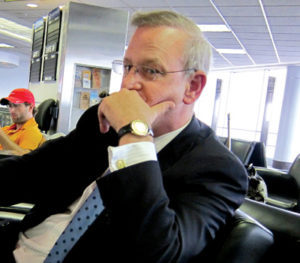 I was surprised to see Bill Poquette’s editorial channeling the Bank Policy Institute’s assertion that The Clearing House deserved a monopoly for real time payments in the United States. The idea that only TCH should provide this service and that competition from the Federal Reserve banks or others would hinder progress is wrong and inconsistent with over 100 years of experience. As he notes, the Bank Policy Institute is an instrument of TCH banks, and making public policy decisions from its viewpoint would adversely affect the payments system for decades to come.
I was surprised to see Bill Poquette’s editorial channeling the Bank Policy Institute’s assertion that The Clearing House deserved a monopoly for real time payments in the United States. The idea that only TCH should provide this service and that competition from the Federal Reserve banks or others would hinder progress is wrong and inconsistent with over 100 years of experience. As he notes, the Bank Policy Institute is an instrument of TCH banks, and making public policy decisions from its viewpoint would adversely affect the payments system for decades to come.
I acknowledge TCH’s many years as a participant in the payments business. However, if we are to use history as a guide, evidence shows that having the Federal Reserve banks operating within the payments system has tremendously benefited the public.
- One hundred years ago, one of the Fed’s first significant actions was to end non-par pay-ments in this country so that a check written for $100 actually paid a bill for that amount.
- The Federal Reserve’s operational leadership in payments increased the efficiency of check payments by fostering the introduction of MICR encoding.
- As an operator, the Federal Reserve brought forward the ACH system that TCH acknowl-edges as a major improvement in the payments system.
- Through Check 21, the Federal Reserve’s initiative to transform check clearing from a paper to electronic process, the speed with which payments could be completed was accelerated and the system was hardened against disruptions in air transportation.
- And, particularly relevant to today’s debate, it was the Federal Reserve’s leadership that initiated the movement in the United States toward real time payments when, in 2013, it announced its focus on improving the U.S. payments system.
The Federal Reserve’s record in developing and operating payments systems and successfully competing in that market has not been lost on TCH. To suggest the Federal Reserve has been slow to provide such payments ignores the enormous lobbying effort that TCH has undertaken to keep the Fed on the sidelines to the detriment of those who will no longer be able to choose their provider. The economic rents TCH will extract from the public over time will be in the billions of dollars and make any investment by the Fed pale in comparison.
Payments is a market in which a quadrillion dollars in transactions, involving nearly every individual and business in the country, are completed annually. This market will be best served with more than one participant. And, it is to the public’s advantage that the Federal Reserve is, by statute, far more transparent than TCH in setting prices. A more competitive and more transparent market assures that a participant’s success depends on low-cost pricing, high-quality products and consistent reliability. Such a system serves the public far better than a regulated monopolist, which too often captures its regulator.
The Bank Policy Institute argues that TCH faces competition from same-day ACH, card networks and fintechs as if they were the equivalent of real time, retail payments. They are not. Immediate payment is very distinct from other methods of payment. These other systems will not be competitors but rather will depend on this new system and be subject to the whims of a monopolist should there be only one provider. This fact further explains why TCH is working so desperately to keep the Federal Reserve on the sidelines.
TCH and thousands of banks were able to continue operations during past crises because the Federal Reserve, as a provider of payments, was able to take on the enormous risks and responsibilities of completing payments when settlement was extremely uncertain. A compelling example is 9/11. During this national crisis, the Fed continued accepting checks, giving credit for deposits but deferring debits to the paying banks until the checks could finally be presented. The Fed took on these risks and absorbed these costs as part of its business expense. During this traumatic period, TCH, like others, counted on the Fed to assure a working payments system.
Rather than look to the Bank Policy Institute as an extension of TCH for guidance, I suggest we look instead at the Fed’s historical record in payments, the assessment of the GAO in a 2016 report, the U.S. Treasury in a 2018 report, and the sentiment of public comments provided last fall in response to a request for comment. These sources overwhelmingly conclude that the Federal Reserve’s participation in real time payments will raise the performance and accountability of both systems.
I welcome any opportunity to engage in a discussion with TCH on this important issue.
Thomas Hoenig is a former president of the Federal Reserve Bank of Kansas City and former vice chairman of the FDIC.
